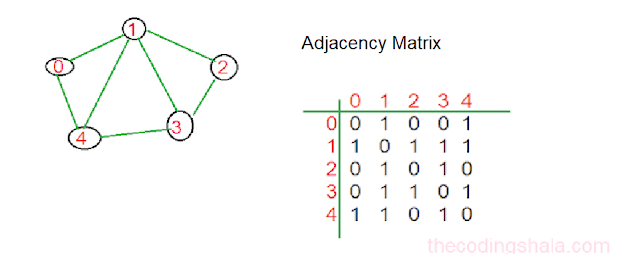Graph Representation Using Adjacency List - The Coding Shala
Home >> Data Structures >> Graph Representation Using Adjacency List
Other Posts You May Like
Please leave a comment below if you like this post or found some error, it will help me to improve my content.
Graph Representation Using Adjacency List
In this post, we will see how to represent a Graph using the Adjacency List. We used an array of lists. The Size of the array is the number of vertices and arr[i] represents the list of vertices adjacent to the ith vertex. The following example shows how to represent a graph using adjacency list:
Graph Representation using Adjacency list Java Program
We have given the number of edges 'E' and vertices 'V' of a bidirectional graph. Now our task is to build a graph through the adjacency list and print the adjacency list for each vertex.
Example 1:
Input:
5 7 //vertex and edges
0 1
0 4
1 2
1 3
1 4
2 3
3 4
Output:
0-> 1-> 4
1-> 0-> 2-> 3-> 4
2-> 1-> 3
3-> 1-> 2-> 4
4-> 0-> 1-> 3
Java Code:
import java.util.*; class Graph{ int v; LinkedList<Integer>[] adjList; Graph(int v){ this.v = v; adjList = new LinkedList[v]; for(int i=0; i<v; i++){ adjList[i] = new LinkedList(); } } void Connect(int point1, int point2){ adjList[point1].add(point2); adjList[point2].add(point1); //bidirectional } void Display(){ for(int i=0; i<v; i++){ System.out.print(i); //print node for(Integer curr : adjList[i]){ System.out.print("-> "+curr); } System.out.println(); } } } class Main{ public static void main(String[] args){ Scanner sc = new Scanner(System.in); int tc = sc.nextInt(); //no. of test cases while(tc-->0){ int vertex = sc.nextInt(); int edges = sc.nextInt(); Graph g = new Graph(vertex); while(edges-->0){ int v1 = sc.nextInt(); int v2 = sc.nextInt(); g.Connect(v1, v2); } g.Display(); } } }
Other Posts You May Like
- Design Linked List
- Introduction to String
- Introduction to Array
- Find Number of Islands
- Height of a Binary Tree
Prev<< Introduction to Graph Data Structure NEXT >>#



Comments
Post a Comment